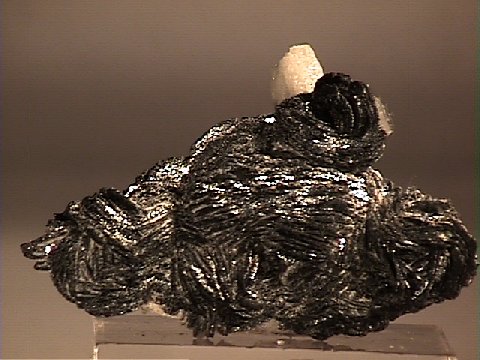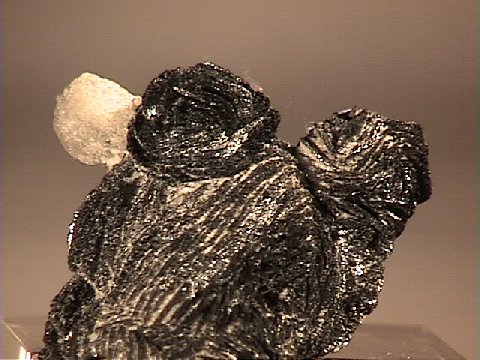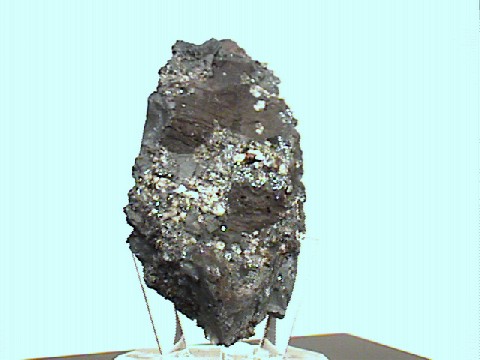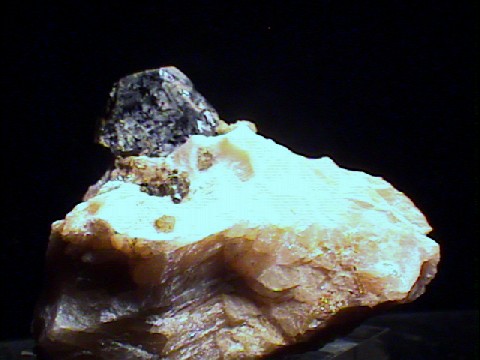 THE MINERAL ILMENITE
THE MINERAL ILMENITE
- Chemical Formula: FeTiO3, Iron Titanium Oxide
- Class: Oxides and Hydroxides
- Group: Hematite
- Subgroup: Ilmenite
- Uses: As the major ore of titanium, a minor ore of iron, as a flux in blast furnaces, as an abrasive and as mineral specimens.
Specimens
Ilmenite is an economically important and interesting mineral. It is named for its place of discovery (such places are called type localities) at Ilmen Lake in the Ilmen Mountains, Miask in the southern portion of the
Since its discovery, the mineral ilmenite has grown greatly in its importance. It is now the most important ore of titanium. Titanium was at one time a metal that had little use and basically no one knew what to do with it. Even as late as 1946 when the metal was finally shown to be capable of being produced commercially, it was considered a "laboratory curiosity". Since that time, titanium has been shown to be a strong aluminum-like metal; light weight, non-corrosive, able to withstand temperature extremes (especially its high melting point, 1800 degrees C) and it has good strength (as strong as steel and twice as strong as aluminum). Titanium alloys have found many applications in high tech airplanes, missiles, space vehicles and even in surgical implants.
Additionally, titanium dioxide TiO2, is a white pigment that is used more and more in paints as lead paint is discontinued due to health considerations. In fact, the largest percentage (up to 95%) of world wide use for titanium is for the production of this white pigment. The pigment has great luster, good endurance, high opacity (it hides whatever is under it, important for paint) and a pure white color. The pigment is also used to provide color for rubber, plastics, textiles, ink, cosmetics, leather, ceramics and paper. Titanium and titanium compounds have found uses in desalination plants, electrical components, glass products, artificial gemstones, jewelry and even as smoke screens. Ilmenite is mined in Australia, Brazil, Russia, Canada, Sri Lanka, Norway, China, South Africa, Thailand, India, Malaysia, Sierra Leone and the United States.
Ilmenite is not the only source of titanium.
There are several common to relatively rare titanium minerals such as
rutile,
sphene,
brookite,
anatase,
However, in sedimentary detrital deposits known as "placers", both minerals can be concentrated into useable ores. Placers occur when a heavy, resistant mineral is mechanically and gravitationally sorted by natural processes into a recoverable deposit. Placers occur in river bends or behind river obstacles and in ocean shoreline sand deposits where slower water currents allow the heavier minerals to settle. Placer deposits often contain both rutile and ilmenite and there are enough of these deposits around the world to supply us with titanium for decades if not centuries.
Ilmenite is a metallic to submetallic mineral that is generally iron black. At times it can form brightly lustered intricately faceted crystals or radial clusters arranged in a rosette fashion. Platy hexagonal crystals with rhombohedral faces on the edges can appear very similar to hematite's tabular habits. However hematite has a distinctly different streak. Magnetite is also similar and easily confused with ilmenite, but ilmenite has a different crystal form and is not as strongly magnetic. It is often associated with magnetite and therefore ilmenite is a minor ore of iron as the magnetite and ilmenite are processed for their iron contents. Ilmenite by itself is not a profitable iron ore as the titanium inhibits the smelting process.
Ilmenite, hematite and corundum all have similar structures and belong to a more or less informal group called the Hematite Group with a general formula of A 2O3. The structure is composed of alternating layers of cations and oxygens. The cations occupy sites in the layers between the oxygen layers and each are bonded to three oxygens in the above layer and three oxygens in the bottom layer. Not all of the sites available for these cations are occupied as only two out of three are filled. If all the sites were filled, then the formula would be AO in stead of A2O3.
In ilmenite and other members of the Ilmenite Group, alternating layers of cations are occupied by just titanium ions and the other cation layer are occupied only by iron ions and form an ordered sequence of Ti/O/Fe/O/Ti/O/Fe . . . . This effectively lowers the symmetry of ilmenite (which is bar 3) from the other Hematite Group members (which are bar 3 2/m). The other members are more symmetrical because their A cations are all the same and thus there is no ordering of their stacking sequence. Compare the same symmetry phenomena that occurs between the Calcite Group and the Dolomite Group of carbonates.
Ilmenite lends it name to a group of similar, simple, trigonal, titanium oxides called the Ilmenite Group, a subgroup of the Hematite Group of minerals. The general formula for the group is ATiO3; where the A can be either iron, magnesium, zinc and/or manganese. The Ilmenite Group members differ from the other members of the Hematite Group in that the structure is more ordered with the titaniums and A ions occupying alternating layers between the oxygen layers (see above). The oxygen layers are hexagonally packed. Each metal ion is bonded to three oxygens in the oxygen layer above and three oxygens in the layer below. All the members, except for ilmenite, are very uncommon to rare.
- These are the members of the Ilmenite Group
Ecandrewsite (Zinc Iron Manganese Titanium Oxide)Geikielite (Magnesium Titanium Oxide)- Ilmenite (Iron Titanium Oxide)
Pyrophanite (Manganese Titanium Oxide)
PHYSICAL CHARACTERISTICS:
- Color is black.
- Luster is metallic, submetallic to dull when tarnished.
- Transparency: Crystals are opaque.
- Crystal System: Trigonal; bar 3
- Crystal Habits include thin and thick tabular crystals with rhombohedral truncations (similar to hematite's tabular habits); sometimes formed into rosettes. Also granular and massive. Occurs as grains in placer sands.
- Cleavage is absent.
- Fracture is conchoidal or uneven.
- Hardness is 5 - 6
- Specific Gravity is 4.5 - 5.0 (average for metallic minerals).
- Streak is brownish black.
- Other Characteristics: Sometimes magnetic (will always become magnetic if heated) and there is basal and rhombohedral parting.
- Associated Minerals include zircon, hematite, magnetite, rutile, spinel, analcime, albite, apatite, monazite, calcite, natrolite, microcline, olivine, pyrrhotite, biotite nepheline and quartz.
- Notable Occurrences are wide spread and include the type locality from where it gets its name, Ilmen Lake in the Ilmen Mountains, Miask in the Southern portions of the
Ural Mountain Chain , Russia as well as Sweden; Germany; Froland, Arendal and Kragero, Norway; Gilgit, Pakistan; Allard Lake and Mont Saint-Hilaire, Quebec andBancroft , Ontario, Canada; Finland; the Eastern Shores of Australia and Brazil, Sri Lanka, China, Thailand, South Africa, India, Malaysia, Sierra Leone and in Orange County and Essex County, New York; Iron Mountain, Wyoming; Chester, Massachusetts; several sites in California and along the eastern seaboard of the United States. - Best Field Indicators are crystal habit, density, lack of cleavage, luster, associations and streak.







